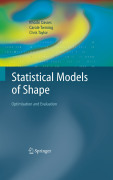
Statistical models of shape: optimisation and evaluation
Davies, R.
Twining, C.
Taylor, C.
Deformable shape models have wide application in computer vision and biomedical image analysis. This book addresses a key issue in shape modelling: establishment of a meaningful correspondence between a set of shapes. Correspondence has traditionally been established by manual annotation of the data, however this is a time-consuming and error-prone process that does not extend easily to3D. Thus, almost all applications of statistical shape models have been restricted to 2D objects. This book explores a particular approach to establishing correspondence that casts model-building as an optimisation problem. A generalframework is established to find the correspondence that optimises an objective function of model quality. Efficient methods, including implementation details, are presented for manipulating correspondences and for optimising the objective function. Practical example applications are presented for 2D as well as for 3D sets of shapes. Establishing a meaningful correspondence between a set of shapes is a key issue in shape modelling which is addressed in this book Practical example applications are presented for both 2D and 3D sets of shapes INDICE: Introduction.-Statistical Models of Shape and Appearance.- Establishing Correspondence.- Objective Functions.- Re-parameterisation of Open and Closed Curves.- Parameterisation and Re-parameterisation of Surfaces.- Optimisation.- Non-parametric Regularization.- Evaluation of Statistical Models.- Appendix A Thin-Plate and Clamped Plate-Plate Splines.- Appendix B Differentiatingthe Objective Function.- Glossary.- References.- Index.
- ISBN: 978-1-84800-137-4
- Editorial: Springer
- Encuadernacion: Cartoné
- Páginas: 320
- Fecha Publicación: 01/08/2008
- Nº Volúmenes: 1
- Idioma: Inglés
